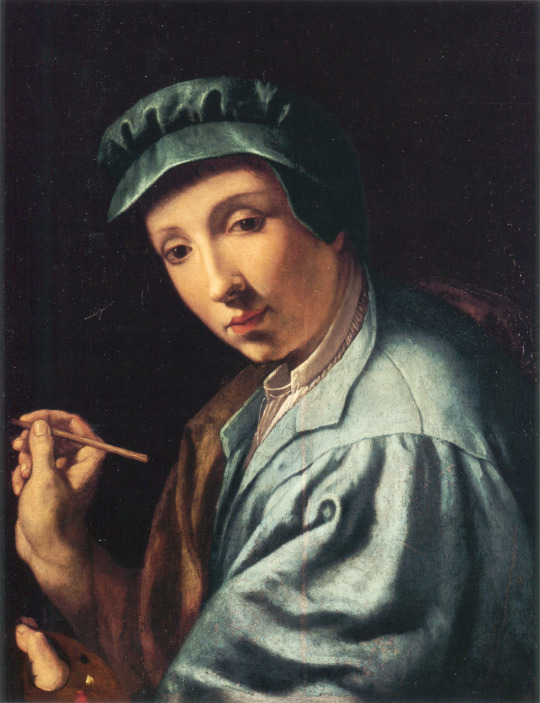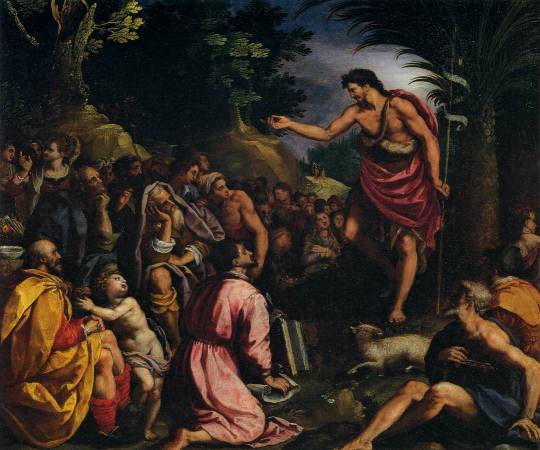By: Amy Fredrickson
Prolific Florentine painter Alessandro di Cristofano di Lorenzo del Bronzino Allori (1535–1607) was born on May 31, 1535. After the death of his father, a sword maker, in 1540, five-year-old Allori was adopted and trained by Agnolo Bronzino, a Medici Court painter and a preeminent Florentine portraitist. Subsequently, Allori grew up in Bronzino’s workshop, and his career and paintings would be forever intertwined with those of Bronzino. In Lives, Vasari mentioned the strong artistic lineage of Florentine painters such as Pontormo, Bronzino, and Allori.
Bronzino instructed the young Allori, who absorbed his master’s style of meticulous drawings, statuesque figures, and polished, enamel-like surfaces that often characterized Bronzino’s works.
In 1554, Allori traveled to Rome to study antique sculpture as well as contemporary art and architecture, including Michelangelo’s paintings. During his first documented return to Florence, he was to execute an altarpiece of The Last Judgment and a fresco cycle for the Montauti Chapel in Santissima Annunziata in 1560. Allori’s altarpiece illustrates Michelangelo’s influence through the incorporation of complicated, twisting poses. Elegant, elongated figures and twisting poses became typical facets of Florentine Mannerism.
Allori’s return to Florence also coincided with Medici commissions. Like Bronzino, Allori worked as a court painter, producing altarpieces, cabinet miniatures, portraits, and tapestries. He also designed fresco cycles for Florentine villas and churches. Allori participated in several projects related to the newly established Accademia del Disegno (1563), including the preparation of decorations for Michelangelo’s funeral in 1564 and the marriage of Grand Duke Cosimo I’s son, Francesco I, to Joanna of Austria in 1665.
Francesco I hired Allori along with twenty-three other artists to paint works for his Studiolo, a tiny chamber in Palazzo Vecchio that is only accessible by a hidden spiral staircase. The small room was dedicated to the studies of geology, mineralogy, and alchemy, subjects that Francesco I had studied.
Allori contributed his masterpiece, The Pearl Fishers (ca. 1569–1575), in which he portrayed elegant male and female nudes, both human and mythological. In the foreground, nymphs hold conch shells overflowing with pearls, while in the background, figures dive from overcrowded boats to harvest coral and pearls. Allori quoted the central nude figure from Michelangelo’s unfinished work Battle of Cascina. Allori’s use of colors, such as warm pinks and cool blues, create an otherworldly scene.
Continuing this artistic lineage, Allori trained his son, Cristofano (1577–1621), who became one of the leading Florentine painters of his period. His style, unlike his father’s, was characterized by more natural figures as he turned toward Baroque trends. He abandoned the enamel-like subjects and incorporated vibrant Venetian coloring with Florentine designs.
Alessandro Allori is one of the last notable examples of Mannerism. In many ways, Allori’s works are an homage to past Florentine artists such as Andrea del Sarto, Fra Bartolomeo, Leonardo, Pontormo, and Bronzino. While Alessandro Allori died in 1607, Mannerism lost vigor and fell out of fashion years before his death.
Images:
Self Portrait, c. 1555, oil on panel, 60 cm x 47 cm, Galleria degli Uffizi, Florence.
Venus Disarming Cupid, c. 1570, oil on wood, Paintings, 139.7 × 226.06 cm, Los Angeles County Museum of Art, Los Angeles.
The Preaching of St John the Baptist, 1601-03, oil on copper, 39 x 47 cm, Galleria Palatina (Palazzo Pitti), Florence
Susanna and The Elders, 1561, oil on canvas, 202 x 117 cm, Musée Magnin, Dijon.
Saint Peter Walking on the Water, 1590s, oil on copper, 47 x 40 cm, Galleria degli Uffizi, Florence
Annunciation, 1603, Oil on canvas, Galleria dell’Accademia, Florence
The Pearl Fishers, ca. 1569–1575, oil on slate, 116 x 86 cm, Palazzo Vecchio, Florence.
Bibliography:
Cole, Michael, “Grazzini, Allori and Judgment in the Montauti Chapel,” Mitteilungen Des Kunsthistorischen Institutes in Florenz 45, no. ½, 2001, p. 302-12.
Langdon, Gabrielle, Medici Women: Portraits of Power, Love, and Betrayal in the Court of Duke Cosimo I, (University of Toronto Press, 2007).
Markey, Lia, Imagining the Americas in Medici Florence, (The Pennsylvania State University Press, 2016).
Pilliod, Elizabeth, Bronzino, and Allori : A Genealogy of Florentine Art, (Yale University Press, 2001).
Vasari, Giorgio, Julia Conaway Bondanella and Peter E. Bondanella, eds. The Lives of the Artists, (Oxford University Press, 1998).







